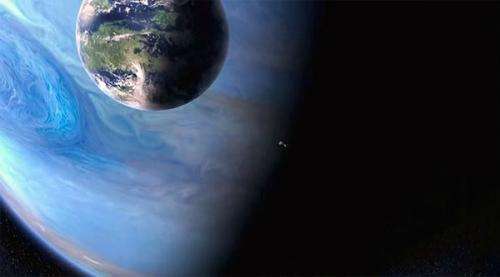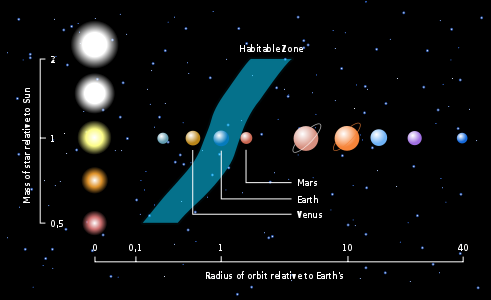March 7, 2012 weblog
Do moons of gas giants affect the habitable zone?

(PhysOrg.com) -- If you aren’t familiar with the Drake Equation, or how it may actually apply to exomoons, continue reading to learn more about the famous equation. Additionally, what conditions could make a habitable moon like Pandora as depicted in Avatar, or the forest Moon of Endor as seen in Return of the Jedi?
What exactly is the Drake Equation? Created in 1961 by SETI founder Frank Drake, the Drake Equation attempts to explore the specific factors that may affect the development of intelligent civilizations elsewhere in our Galaxy.
The equation is as follows (Courtesy of SETI):
N = R* • fp • ne • fl • fi • fc • L
Where:
- N = The number of civilizations in The Milky Way Galaxy whose electromagnetic emissions are detectable.
- R* =The rate of formation of stars suitable for the development of intelligent life.
- fp = The fraction of those stars with planetary systems.
- ne = The number of planets, per solar system, with an environment suitable for life.
- fl = The fraction of suitable planets on which life actually appears.
- fi = The fraction of life bearing planets on which intelligent life emerges.
- fc = The fraction of civilizations that develop a technology that releases detectable signs of their existence into space.
- L = The length of time such civilizations release detectable signals into space.
By adjusting one (or more) parameters in the equation, you can come up with estimates for habitable worlds (with intelligent life) in our Galaxy. While there isn't any specific solution to the Drake Equation, many researchers use the equation as a basic learning and exploration tool. When new discoveries are made, such as exoplanet discoveries, additional data can be used in the Drake Equation. Keep in mind that the Drake Equation was created 34 years prior to the confirmation of the first exoplanet in 1995!

So how does all this fit in with the habitable zone?
The image above is an infographic showing where the habitable zone would be in our Solar System, given different classes of stars. The habitable zone is merely a region where, given proper atmospheric conditions, liquid water could exist in a stable form on the surface of a body. As you can see, a smaller, dimmer star would produce a habitable zone closer to the central star, and a larger, brighter star would push this habitable zone further out.
In short, the habitable zone is (mostly) determined by the luminosity of the central star.
But wait, there’s more!
Just because a world isn’t in the habitable zone doesn’t necessarily mean it can’t have liquid water. Look at moons such as Europa or Enceladus. While the first impression of these icy worlds is that of a giant ball of ice, it is theorized that tidal flexing may heat the interiors of these worlds and provide an environment where subsurface liquid water may exist.
Keep in mind that the distance between a world and its host star can only provide an educated guess as to whether or not liquid water can exist on its surface. There are other factors such as the composition of the world itself (both surface and atmospheric), and that the mechanism for providing planets with water still isn’t completely understood.
To sum everything up, if astronomers detect a gas giant planet outside the habitable zone of its parent star, there’s still a chance it may harbor habitable moons - well, at least habitable for basic life. If a Jupiter-class planet is detected in the habitable zone of its parent star, it is well within the realm of possibilities for an Earth-like habitable moon to exist in orbit around said planet.
Of course, said detections are still a few years away - currently researchers can detect exoplanets a bit smaller than Mars, and are working on ways to detect moons orbiting around large exoplanets. As for updating Drake’s famous equation - we can probably just replace planet with world and continue our search for life elsewhere in our Galaxy.
More information: www.dearastronomer.com/2012/03 … t-the-habitable-zone
© 2011 PhysOrg.com




















